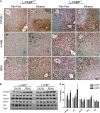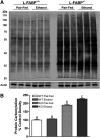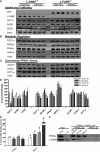Susceptibility of L-FABP-/- mice to oxidative stress in early-stage alcoholic liver
- PMID: 23359610
- PMCID: PMC3622328
- DOI: 10.1194/jlr.M034892
Susceptibility of L-FABP-/- mice to oxidative stress in early-stage alcoholic liver
Abstract
Chronic ethanol consumption is a prominent cause of liver disease worldwide. Dysregulation of an important lipid uptake and trafficking gene, liver-fatty acid binding protein (L-FABP), may contribute to alterations in lipid homeostasis during early-stage alcoholic liver. We have reported the detrimental effects of ethanol on the expression of L-FABP and hypothesize this may deleteriously impact metabolic networks regulating fatty acids. Male wild-type (WT) and L-FABP(-/-) mice were fed a modified Lieber-DeCarli liquid diet for six weeks. To assess the response to chronic ethanol ingestion, standard biochemical indicators for alcoholic liver disease (ALD) and oxidative stress were measured. Ethanol ingestion resulted in attenuation of hepatic triglyceride accumulation and elevation of cholesterol in L-FABP(-/-) mice. Lipidomics analysis validated multiple alterations in hepatic lipids resulting from ethanol treatment. Increased immunohistochemical staining for the reactive aldehydes 4-hydroxynonenal and malondialdehyde were observed in WT mice ingesting ethanol; however, L-FABP(-/-) mice displayed prominent protein adducts in liver sections evaluated from pair-fed and ethanol-fed mice. Likewise, alterations in glutathione, thiobarbituric acid reactive substances (TBARS), 8-isoprostanes, and protein carbonyl content all indicated L-FABP(-/-) mice exhibit high sustained oxidative stress in the liver. These data establish that L-FABP is an indirect antioxidant protein essential for sequestering FFA and that its impairment could contribute to in the pathogenesis of ALD.
Figures




Similar articles
-
Diet-induced alterations in intestinal and extrahepatic lipid metabolism in liver fatty acid binding protein knockout mice.Mol Cell Biochem. 2009 Jun;326(1-2):79-86. doi: 10.1007/s11010-008-0002-4. Epub 2008 Dec 31. Mol Cell Biochem. 2009. PMID: 19116776 Free PMC article.
-
Characterization of 4-HNE modified L-FABP reveals alterations in structural and functional dynamics.PLoS One. 2012;7(6):e38459. doi: 10.1371/journal.pone.0038459. Epub 2012 Jun 6. PLoS One. 2012. PMID: 22701647 Free PMC article.
-
Protein carbonylation in a murine model for early alcoholic liver disease.Chem Res Toxicol. 2012 May 21;25(5):1012-21. doi: 10.1021/tx300002q. Epub 2012 May 1. Chem Res Toxicol. 2012. PMID: 22502949 Free PMC article.
-
Overview of lipid peroxidation products and hepatic protein modification in alcoholic liver disease.Chem Biol Interact. 2011 Jun 30;192(1-2):107-12. doi: 10.1016/j.cbi.2011.02.021. Epub 2011 Feb 24. Chem Biol Interact. 2011. PMID: 21354120 Free PMC article. Review.
-
n-3 Polyunsaturated fatty acids for the management of alcoholic liver disease: A critical review.Crit Rev Food Sci Nutr. 2019;59(sup1):S116-S129. doi: 10.1080/10408398.2018.1544542. Epub 2018 Dec 22. Crit Rev Food Sci Nutr. 2019. PMID: 30580553 Review.
Cited by
-
Global Cysteine-Reactivity Profiling during Impaired Insulin/IGF-1 Signaling in C. elegans Identifies Uncharacterized Mediators of Longevity.Cell Chem Biol. 2016 Aug 18;23(8):955-66. doi: 10.1016/j.chembiol.2016.06.015. Epub 2016 Aug 4. Cell Chem Biol. 2016. PMID: 27499530 Free PMC article.
-
MicroRNA-200c coordinates HNF1 homeobox B and apolipoprotein O functions to modulate lipid homeostasis in alcoholic fatty liver disease.J Biol Chem. 2022 Jun;298(6):101966. doi: 10.1016/j.jbc.2022.101966. Epub 2022 Apr 20. J Biol Chem. 2022. PMID: 35460694 Free PMC article.
-
Quantitative Lipid Profiling Reveals Major Differences between Liver Organoids with Normal Pi*M and Deficient Pi*Z Variants of Alpha-1-antitrypsin.Int J Mol Sci. 2023 Aug 5;24(15):12472. doi: 10.3390/ijms241512472. Int J Mol Sci. 2023. PMID: 37569847 Free PMC article.
-
Evaluation of the Developmental Toxicity Induced by E804 in Zebrafish Embryos.Front Pharmacol. 2020 Feb 14;11:32. doi: 10.3389/fphar.2020.00032. eCollection 2020. Front Pharmacol. 2020. PMID: 32116709 Free PMC article.
-
Differential contribution of complement receptor C5aR in myeloid and non-myeloid cells in chronic ethanol-induced liver injury in mice.Mol Immunol. 2016 Jul;75:122-32. doi: 10.1016/j.molimm.2016.05.006. Epub 2016 Jun 6. Mol Immunol. 2016. PMID: 27280845 Free PMC article.
References
-
- Lucey M. R., Mathurin P., Morgan T. R. 2009. Alcoholic hepatitis. N. Engl. J. Med. 360: 2758–2769 - PubMed
-
- Zakhari S., Li T. K. 2007. Determinants of alcohol use and abuse: impact of quantity and frequency patterns on liver disease. Hepatology. 46: 2032–2039 - PubMed
-
- Nagy L. E. 2004. Molecular aspects of alcohol metabolism: transcription factors involved in early ethanol-induced liver injury. Annu. Rev. Nutr. 24: 55–78 - PubMed
Publication types
MeSH terms
Substances
Grants and funding
- F31 AA018898/AA/NIAAA NIH HHS/United States
- P30-DK-052574/DK/NIDDK NIH HHS/United States
- F31-AA-018898-03/AA/NIAAA NIH HHS/United States
- R37-AA-09300/AA/NIAAA NIH HHS/United States
- R01-DK-56260/DK/NIDDK NIH HHS/United States
- R01 HL038180/HL/NHLBI NIH HHS/United States
- R01-DK-074487-01/DK/NIDDK NIH HHS/United States
- R0-HL-38180/HL/NHLBI NIH HHS/United States
- R01 DK074487/DK/NIDDK NIH HHS/United States
- R37 AA009300/AA/NIAAA NIH HHS/United States
- R01 DK056260/DK/NIDDK NIH HHS/United States
- P30 DK052574/DK/NIDDK NIH HHS/United States
LinkOut - more resources
Full Text Sources
Other Literature Sources
Molecular Biology Databases

